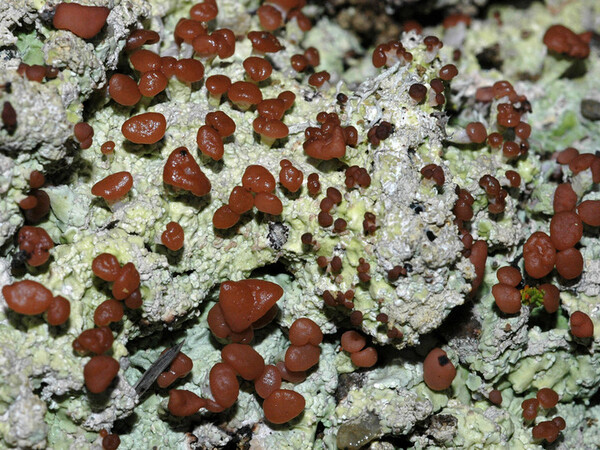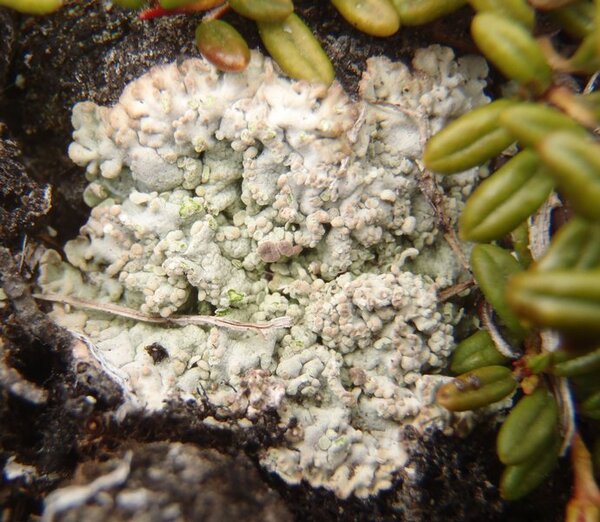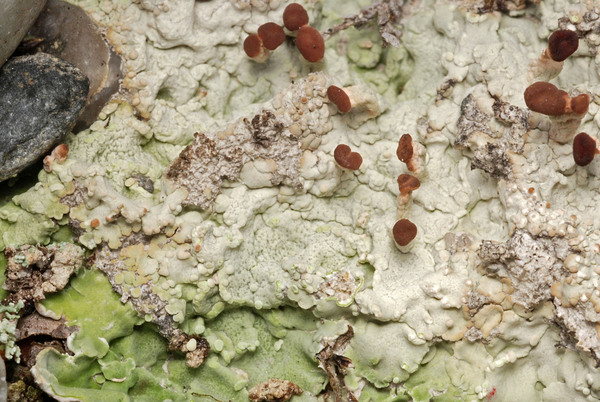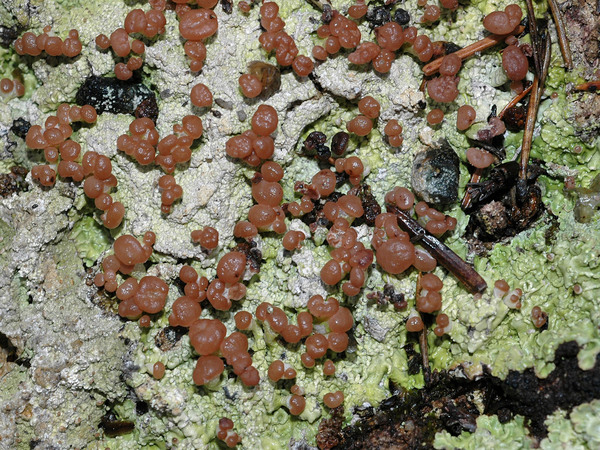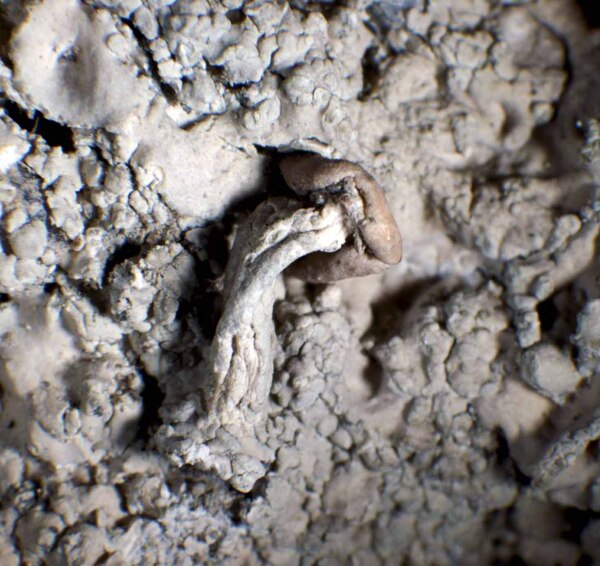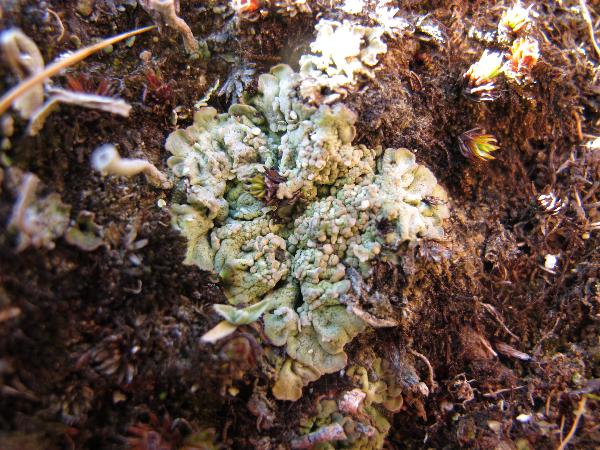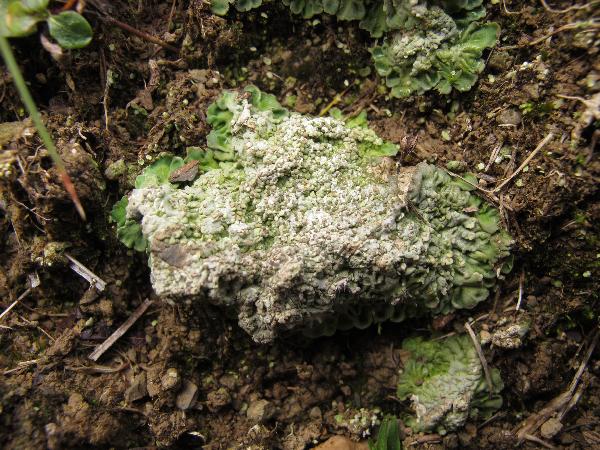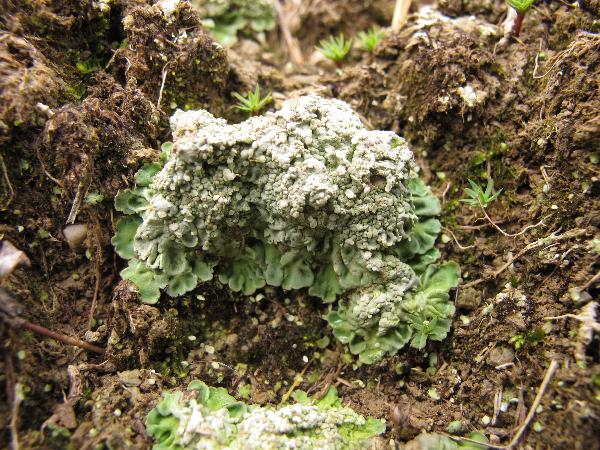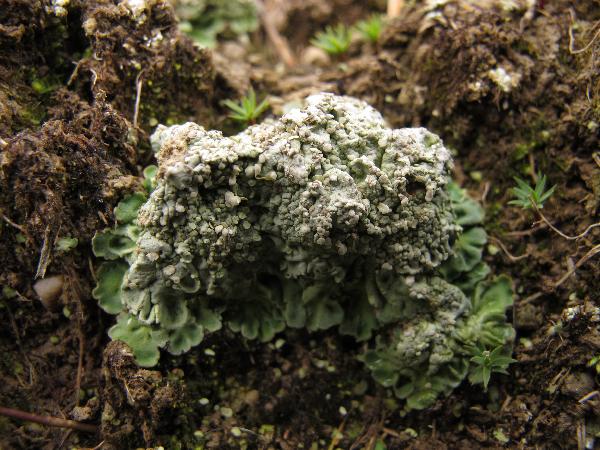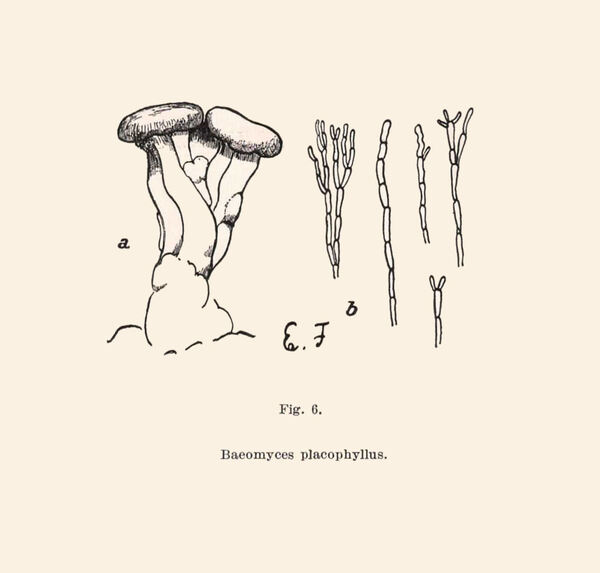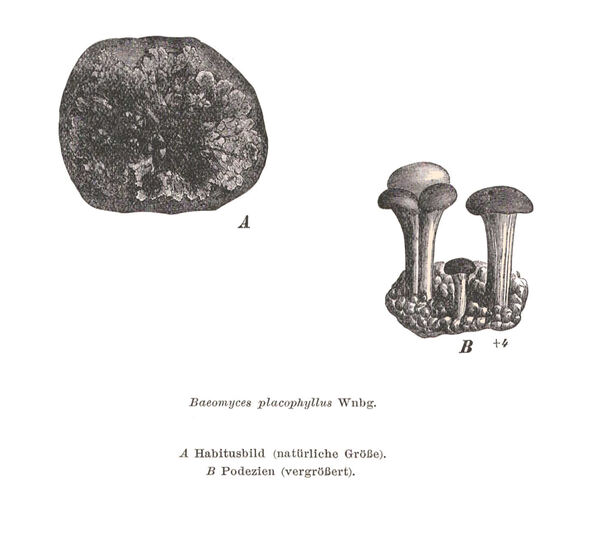Baeomyces placophyllus Ach.
Meth. Lich.: 323, 1803.
Synonyms: Ludovicia placophylla (Ach.) Trevis.
Distribution: N - Frl (Tretiach & Hafellner 2000), Ven (Tretiach 1993), TAA (Nascimbene 2008b, Nascimbene & al. 2022), Lomb (Ravera & al. 2021b), Piem (Isocrono & al. 2004), VA (Piervittori & al. 2004).
Description: Primary thallus crustose-placodioid, well-delimited, glaucous grey-green to brownish, turning bright green when wet, thick, forming up to 12 cm wide rosettes, the central parts subsquamulose, often covered in peltate, light-coloured, fragile, up to 0.6 mm wide schizidia leaving shallow scars when they fall off, the margins with radiating, up to 6 mm broad, flattened, contiguous, lobes which are often raised at tips. Apothecia frequent, biatorine, emarginate, with an ochraceous to reddish brown, flat, oftem narginally reflexed disc, up to 4(-5) mm across, terminal on furrowed, subfruticose, solid, up to 6 mm tall and to 2 mm thick stipes which are corticate and sometimes microsquamulose in lower part. Epithecium yellowish brown, C+ red; hymenium colourless, 70-120(-150) µm high, K/I-; paraphyses 2-2.5 µm thick at mid-level, slender, simple or sparingly branched towards the tips, not anastomosing, the apical cell c. 3 µm wide; hypothecium pale. Asci 8-spored, cylindrical, thin-walled, the apex truncated, with a single functional wall layer, with a poorly differentiated, non-amyloid tholus. Ascospores 1(-2)-celled, hyaline, fusiform, 8-14(-16) x (2-)3-4(-5.5) µm. Photobiont chlorococcoid. Spot tests: thallus K+ yellow, C-, KC+ orange, P+ orange, UV+ pale yellow; mature apothecia C+ red. Chemistry: thallus with the stictic acid complex, incl. traces of norstictic acid and an unidentified substance; gyrophoric and lecanoric acids in mature apothecia. Note: an arctic-alpine to boreal-montane, probably circumpolar lichen found on sandy-clay soil in open stands (e.g. montane-subalpine grasslands), often in moderately disturbed habitats, sometimes reaching the Alpine belt. Probably restricted to the Alps in Italy.
Growth form: Crustose
Substrata: soil, terricolous mosses, and plant debris
Photobiont: green algae other than Trentepohlia
Reproductive strategy: mainly sexual
Pioneer species
Commonnes-rarity: (info)
Alpine belt: rare
Subalpine belt: rather rare
Oromediterranean belt: absent
Montane belt: extremely rare
Submediterranean belt: absent
Padanian area: absent
Humid submediterranean belt: absent
Humid mediterranean belt: absent
Dry mediterranean belt: absent

Predictive model
Herbarium samples
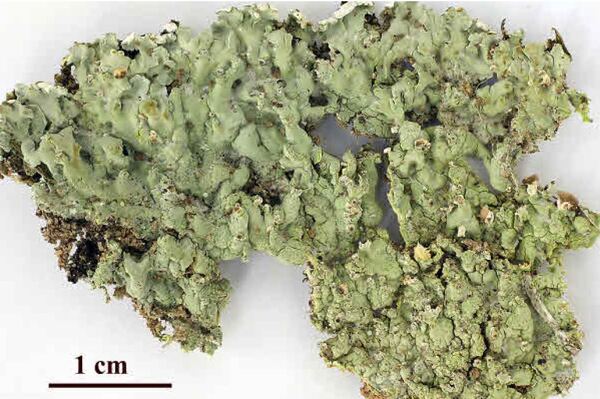

Felix Schumm – CC BY-SA 4.0
[16639], Germany, Rheinland-Pfalz, Naturpark Pfälzer Wald, ca. 2 km südlich von Hofstätten, am Weg zum Annweiler Forsthaus, 49.260193° N, 7.891891° E, 291 m. Leg. et det. Schumm 03.09.2010 (BLAMExkursion).


Felix Schumm – CC BY-SA 4.0
[16639], Germany, Rheinland-Pfalz, Naturpark Pfälzer Wald, ca. 2 km südlich von Hofstätten, am Weg zum Annweiler Forsthaus, 49.260193° N, 7.891891° E, 291 m. Leg. et det. Schumm 03.09.2010 (BLAMExkursion).
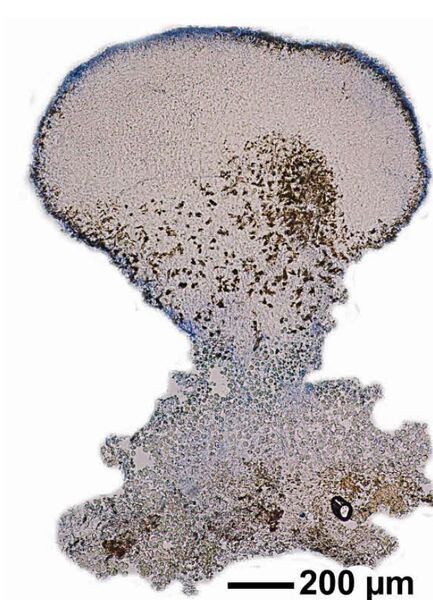

Felix Schumm – CC BY-SA 4.0
[16639], Germany, Rheinland-Pfalz, Naturpark Pfälzer Wald, ca. 2 km südlich von Hofstätten, am Weg zum Annweiler Forsthaus, 49.260193° N, 7.891891° E, 291 m. Leg. et det. Schumm 03.09.2010 (BLAMExkursion).
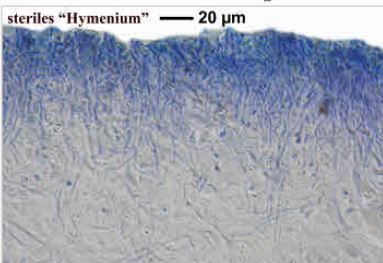

Felix Schumm – CC BY-SA 4.0
[16639], Germany, Rheinland-Pfalz, Naturpark Pfälzer Wald, ca. 2 km südlich von Hofstätten, am Weg zum Annweiler Forsthaus, 49.260193° N, 7.891891° E, 291 m. Leg. et det. Schumm 03.09.2010 (BLAMExkursion).
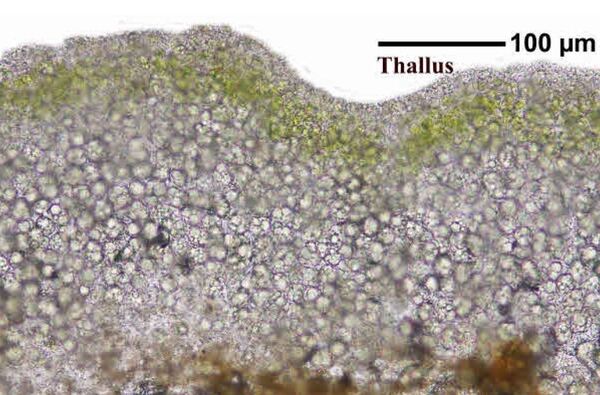

Felix Schumm – CC BY-SA 4.0
[16639], Germany, Rheinland-Pfalz, Naturpark Pfälzer Wald, ca. 2 km südlich von Hofstätten, am Weg zum Annweiler Forsthaus, 49.260193° N, 7.891891° E, 291 m. Leg. et det. Schumm 03.09.2010 (BLAMExkursion).
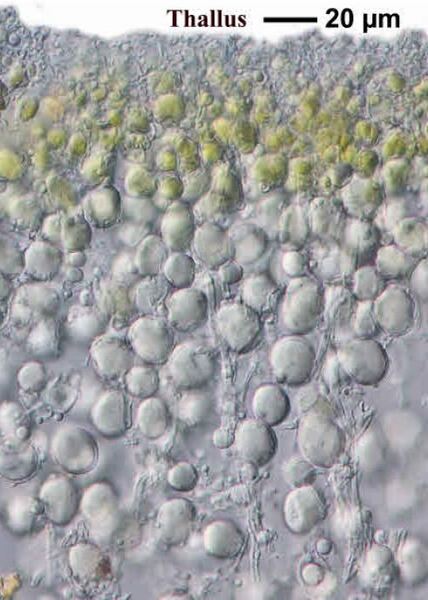

Felix Schumm – CC BY-SA 4.0
[16639], Germany, Rheinland-Pfalz, Naturpark Pfälzer Wald, ca. 2 km südlich von Hofstätten, am Weg zum Annweiler Forsthaus, 49.260193° N, 7.891891° E, 291 m. Leg. et det. Schumm 03.09.2010 (BLAMExkursion).
Growth form: Crustose
Substrata: soil, terricolous mosses, and plant debris
Photobiont: green algae other than Trentepohlia
Reproductive strategy: mainly sexual
Pioneer species
Commonnes-rarity: (info)
Alpine belt: rare
Subalpine belt: rather rare
Oromediterranean belt: absent
Montane belt: extremely rare
Submediterranean belt: absent
Padanian area: absent
Humid submediterranean belt: absent
Humid mediterranean belt: absent
Dry mediterranean belt: absent

Predictive model
| Herbarium samples |


Felix Schumm – CC BY-SA 4.0
[16639], Germany, Rheinland-Pfalz, Naturpark Pfälzer Wald, ca. 2 km südlich von Hofstätten, am Weg zum Annweiler Forsthaus, 49.260193° N, 7.891891° E, 291 m. Leg. et det. Schumm 03.09.2010 (BLAMExkursion).


Felix Schumm – CC BY-SA 4.0
[16639], Germany, Rheinland-Pfalz, Naturpark Pfälzer Wald, ca. 2 km südlich von Hofstätten, am Weg zum Annweiler Forsthaus, 49.260193° N, 7.891891° E, 291 m. Leg. et det. Schumm 03.09.2010 (BLAMExkursion).


Felix Schumm – CC BY-SA 4.0
[16639], Germany, Rheinland-Pfalz, Naturpark Pfälzer Wald, ca. 2 km südlich von Hofstätten, am Weg zum Annweiler Forsthaus, 49.260193° N, 7.891891° E, 291 m. Leg. et det. Schumm 03.09.2010 (BLAMExkursion).


Felix Schumm – CC BY-SA 4.0
[16639], Germany, Rheinland-Pfalz, Naturpark Pfälzer Wald, ca. 2 km südlich von Hofstätten, am Weg zum Annweiler Forsthaus, 49.260193° N, 7.891891° E, 291 m. Leg. et det. Schumm 03.09.2010 (BLAMExkursion).


Felix Schumm – CC BY-SA 4.0
[16639], Germany, Rheinland-Pfalz, Naturpark Pfälzer Wald, ca. 2 km südlich von Hofstätten, am Weg zum Annweiler Forsthaus, 49.260193° N, 7.891891° E, 291 m. Leg. et det. Schumm 03.09.2010 (BLAMExkursion).


 INDEX FUNGORUM
INDEX FUNGORUM
 GBIF
GBIF
 DOLICHENS
DOLICHENS
